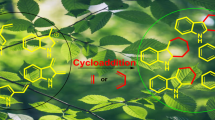Abstract
Two compounds containing carbazole and sulfone groups with different alkyl chain lengths have been designed and synthesized. The sulfone group has strong absorption characteristics and the alkoxy chain and carbazole group are electron-rich, forming D-δ-A-type symmetrical molecules. The molecules have the characteristics of charge transfer and high thermal stability, and the molecules stack to form a layered staggered stack, reducing the intermolecular π–π interactions. The target compounds also exhibit strong ultraviolet-fluorescent emission in the solid state at room temperature, and they are expected to be good luminescent materials.
Graphical Abstract









Similar content being viewed by others
Data Availability
All data generated or analyzed during this study are included in this published article and its supplementary materials.
References
Li G, Zhao J, Zhang D et al (2016) J Mater Chem C 4(37):8787–8794
Zhang Q, Li J, Shizu K et al (2012) J Am Chem Soc 134(36):14706–14709
Xu B, Wu H, Chen J et al (2017) Chem Sci
Li J, Yu Y, Luo L et al (2016) Tetrahedron Lett 57(21):2306–2310
Bui DA, Kraiczek KG, Hauser PC (2017) Molecular absorption measurements with an optical fibre coupled array of ultra-violet light-emitting diodes. Anal Chim Acta 986:95–100
Zhang Q, Zhang X, Wei B (2015) Highly efficient ultraviolet organic light-emitting diodes and interface study using impedance spectroscopy. Optik-Int J Light Electron Opt 126(18):1595–1597
Bae J, Kim YH, Kim HY et al (2015) Ultraviolet light stable and transparent sol–gel methyl siloxane hybrid material for UV light-emitting diode (UV LED) encapsulant. ACS Appl Mater Interfaces 7(2):1035–1039
Taranekar P, Baba A, Fulghum TM et al (2005) Macromolecules 38(9):3679–3687
Bogdal D, Jaskot K (2000) Synth Commun 30(18):3341–3352
Percec S, Tilford S (2011) J Polym Sci Part A: Polym Chem 49(2):361–368
Li L, Liu Y, Guo H et al (2010) Tetrahedron 66(37):7411–7417
Bugatti V, Concilio S, Iannelli P et al (2006) Synth Met 156(1):13–20
Sundararajan G, Rajaraman D, Srinivasan T et al (2015) Synthesis, characterization, computational calculation and biological studies of some2,6-diaryl-1-(prop-2-yn-1-yl) piperidin-4-one oxime derivatives. Spectrochim Acta Part A Mol Biomol Spectrosc 139:108–118
Li R, Yan L, Wang Z et al (2017) An aggregation-induced emissive NIR luminescent based on ESIPT and TICT mechanisms and its application to the detection of Cys. J Mol Struct 1136:1–6
Li X, Mintz EA, Bu XR et al (2000) Tetrahedron 56(32):5785–5791
Galievsky VA, Druzhinin SI, Demeter A et al (2010) J Phys Chem A 114(48):12622–12638
Hou J, Pan Y, Jin JY et al (2009) Isophorone-based analogues with A-π-D-π-A structure for red organic light emitting devices. Synth Met 159(5):401–405
Wang H, Liu H, Bai FQ et al (2015) Theoretical and experimental study on intramolecular charge-transfer in symmetric bi-1,3,4-oxadiazole derivatives. J Photochem Photobiol A 312:20–27
Pawluc P, Franczyk A, Walkowiak J et al (2011) Org Lett 13(8):1976–1979
Paik KL, Baek NS, Kim HK et al (2002) White light-emitting diodes from novel silicon-based copolymers containing both electron-transport oxadiazole and hole-transport carbazole moieties in the main chain. Macromolecules 35(18):6782–6791
Yeh HC, Lee RH, Chan LH et al (2001) Synthesis, properties, and applications of tetraphenyl methane-based molecular materials for light-emitting devices. Chem Mater 13(9):2788–2796
Li D, Huang Z, Shang X et al (2015) Tetrahedron 71(18):2680–2685
Zhang L, Xia Y, Li M et al (2016) Tetrahedron 72(47):7438–7442
Lee J, Liu QD, Motala M et al (2004) Photoluminescence, Electroluminescence, and Complex Formation of Novel N-7-Azaindolyl-and 2, 2-Dipyridylamino-Functionalized Siloles. Chem Mater 16(10):1869–1877
Ren X, Li J, Holmes RJ et al (2004) Ultrahigh energy gap hosts in deep blue organic electrophosphorescent devices. Chem Mater 16(23):4743–4747
Liu XM, Lin T, Huang J et al (2005) Hyperbranched blue to red light-emitting polymers with tetraarylsilyl cores: Synthesis, optical and electroluminescence properties, and ab initio modeling studies. Macromolecules 38(10):4157–4168
Gibson HW, Brumfield KK, Grisle RA et al (2010) Synthesis of heterocyclic monomers via Reissert chemistry. J Polym Sci Part A: Polym Chem 48(17):3856–3867
Mikami A, Mizuno Y, Takeda S (2008) 17.2: High efficiency ultraviolet light emitting organic devices and its application to white light source C. SID Symp Dig Tech Pap 39:215–218
Zhang H et al (2004) J Phys Chem B 108(28):9571–9573
Funding
This work was supported by the National Science Foundation of China (No. 21442004), the education office of Jilin Province (grant No. 2016320).
Author information
Authors and Affiliations
Contributions
Experimental work done and Manuscript written by Huixian Jia, Manuscript checked and supervised by Chenghong Feng,Wanfei Han, Yan Xue,Yanren Jin and Dongfeng Li. All authors read and approved the final manuscript.
Corresponding author
Ethics declarations
Ethics Approval
Not applicable.
Consent to Participate
Not applicable.
Consent for Publication
Not applicable.
Conflict of Interest
The authors declared that there is no conflict of interest.
Additional information
Publisher's Note
Springer Nature remains neutral with regard to jurisdictional claims in published maps and institutional affiliations.
Supplementary Information
Below is the link to the electronic supplementary material.
Rights and permissions
About this article
Cite this article
Jia, H., Feng, C., Han, W. et al. Synthesis and Characterization of Compounds Based on Carbazole and Sulfone Groups. J Fluoresc 32, 267–274 (2022). https://doi.org/10.1007/s10895-021-02844-8
Received:
Accepted:
Published:
Issue Date:
DOI: https://doi.org/10.1007/s10895-021-02844-8




